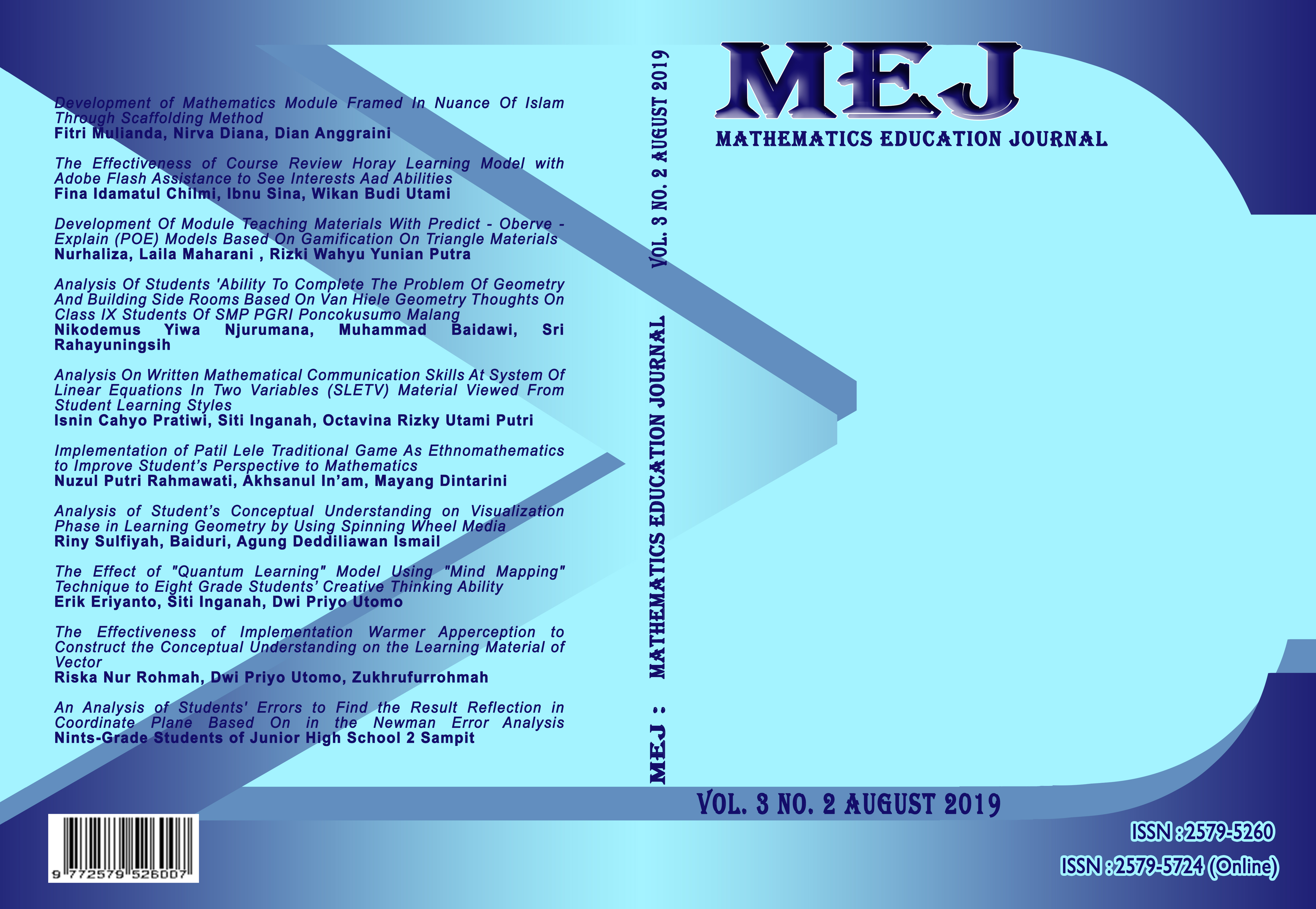An Analysis of Students' Errors to Find the Result Reflection in Coordinate Plane Based On in the Newman Error Analysis Nints-Grade Students of Junior High School 2 Sampit
DOI:
https://doi.org/10.22219/mej.v3i2.11075Keywords:
Analysis, Coordinate Plane, Newman Error Analysis, Reflection, StudentsAbstract
This study aimed to determine the types and the causes of students' errors in finding the results of reflection in the field of coordinates based on the Newman problem-solving. This research used descriptive research with a quantitative approach. The data collection techniques were written test and a structured interview with the research subjects were Nints-grade students of Junior High School 2 Sampit. Based on the results of the data analysis, there were errors made by students, namely: (1) there were no mistakes in the problem of reading stage, (2) students were not able to write down the known and asked even though students understood the questions presented in the stage of understanding the problem, (3) did not change the questions into a coordinate field in the stage of transformation problem, (4) misplaced of the result reflection and miscalculating the result of reflection on the process skill stage, (5) did not writing down the answers or conclusions in the writing answers stage.
Downloads
References
Agusta I. Teknik Pengumpulan dan Analisis Data Kualitatif. Jurnal Studi Komunikasi Dan Media. 2014; 2(1998): 1–11.
Albab IU, Hartono Y, Darmawijoyo D. Kemajuan belajar siswa pada geometri transformasi menggunakan aktivitas refleksi geometri. Jurnal Cakrawala Pendidikan. 2014; 33(3): 338-348
Amalia SR. Analisis Kesalahan Berdasarkan Prosedur Newman Dalam Menyelesaikan Soal Cerita Ditinjau Dari Gaya Kognitif Mahasiswa. Aksioma. 2017; 8(1):17.
Badan Penelitian dan Pengembangan Pusat Kurikulum. Kajian Kebijakan Kurikulum Mata Pelajaran Matematika. Jakarta:Depdiknas, 2007.
Gunawan I. Metode Penelitian Kualitatif. Malang: Universitas Negeri Malang, 2016.
Guven B. Using dynamic geometry software to improve eight grade students’ understanding of transformation geometry. Australasian Journal of Educational Technology. 2012; 28(2): 364–382.
H Sumarjo. Analisi Data Kualitatif dalam Penelitian Teknik Arsitektur. Inersia. 2010; VI(1): 41–51.
Hartati S, Hartono Y. Belajar Pencerminan Dengan Menggunakan Permainan Bom-Boman Di Kelas VII. Jurnal Review Pembelajaran Matematika. 2007; 3(1): 49–61.
Iryana, Kawasati, R. Teknik Pengumpulan Data Metode Kualitatif. Al Riwayah Jurnal Kependidikan. 1990; 4(1); 56–79.
Islamiyah, Anna Citra. Analisis Kesalahan Siswa SMP pada Penyelesaian Masalah Sistem Persamaan Linier Dua Variabel. Jurnal Didaktik Matematika. 2018; 5(1): 66-76
Komarudin. Analisis Kesalahan Pemecahan Masalah Matematika pada Materi Peluang Berdasarkan High Order Thinking. Jurnal Pendidikan, Komunikasi Dan Pemikiran Hukum Islam. 2016; 8(1): 202–217.
Kurniasih MD, Handayani I. Tangkas Geometri Transformasi. jakarta: Universitas Muhammadiyah Prof.Dr.Hamka, 2017.
Lipianto D, Budiarto MT. Analisis kesalahan siswa dalam menyelesakan soal yang berhubungan dengan persegi dan persegipanjang berdasarkan taksonomi solo plus pada kelas vii. Mathedunesa. 2013; 2(1): 1–8.
Nilamsari, S. 2014. Memahami Studi Dokumen Dalam Penelitian Kualitatif. Wacana, 12(2), 5.
Nurhikmah S, Febian. Analisis Kesalahan Siswa dalam Menyelesaikan Permasalahan Integral Tak Tentu. Jurnal Pemikiran Dan Penelitian Pendidikan. 2016; 14(2): 218–237.
Oktaviana D. Analisis Tipe Kesalahan Berdasarkan Teori Newman dalam Menyelesaikan Soal Cerita pada Mata Kuliah Matematika Diskrit. Edusains: Jurnal Pendidikan Sains & Matematika. 2017; 5(2): 1-11.
Pusat Bahasa Departemen Pendidikan Nasional. Kamus Besar Bahasa Indonesia. Jakarta: Depdiknas, 2008.
Rahardjo M. Metode Pengumpulan Data Penelitian Kualitatif. Malang: Universitas Islam Negeri Malang, 2009.
Rahmat SP. Penelitian Kualitatif. Equilibrium.2019; 4(9):1-8.
Rini YS. Pendidikan : Hakekat, Tujuan dan Proses. Jogyakarta : Pendidikan Dan Seni Universitas Negeri Jogyakarta, 2013.
Rosarina G, Sudin A, Sujana A. Penerapan Model Discovery Learning Untuk Meningkatkan Hasil Belajar Siswa Pada Materi Perubahan Wujud Benda. Jurnal Pena Ilmiah. 2016; 1(1): 371–380.
Sahriah S, Muksar M, Lestari T. Analisis Kesalahan Siswa dalam Menyelesaikan Soal Matematika Materi Operasi Pecahan Bentuk Aljabar Kelas VIII SMP Negeri 2 Malang. Online Universitas Negeri Malang. 2012; 1(1):1.
Satoto S, Sutarto H, Pujiastuti E. Analisis Kesalahan Hasil Belajar Siswa dalam Menyelesaikan Soal dengan Prosedur Newman. Unnes Journal of Mathematics Education Research. 2013;2(1):76–83.
Subchan, Winarni, Dkk. Buku Guru Matematika. Jakarta: Kemendikbud, 2010.
Suryana. Metodologi Penelitian : Metodologi Penelitian Model Prakatis Penelitian Kuantitatif dan Kualitatif. Jakarta: Universitas Pendidikan Indonesia, 2010.
Suryana, A. Tahap-tahap Penelitian Kualitatif. Jakarta: Universitas Pendidikan Indonesia, 2017
Downloads
Published
Issue
Section
License
Authors who publish with MEJ (Mathematics Education Journal) agree to the following terms:
For all articles published in MEJ, copyright is retained by the authors. Authors give permission to the publisher to announce the work with conditions. When the manuscript is accepted for publication, the authors agree to automatic transfer of the publishing right to the publisher.
Authors retain copyright and grant the journal right of first publication with the work simultaneously licensed under a Creative Commons Attribution-ShareAlike 4.0 International License that allows others to share the work with an acknowledgment of the work's authorship and initial publication in this journal.
Authors are able to enter into separate, additional contractual arrangements for the non-exclusive distribution of the journal's published version of the work (e.g., post it to an institutional repository or publish it in a book), with an acknowledgment of its initial publication in this journal.
Authors are permitted and encouraged to post their work online (e.g., in institutional repositories or on their website) prior to and during the submission process, as it can lead to productive exchanges, as well as earlier and greater citation of published work (See The Effect of Open Access).

This work is licensed under a Creative Commons Attribution-ShareAlike 4.0 International License.










